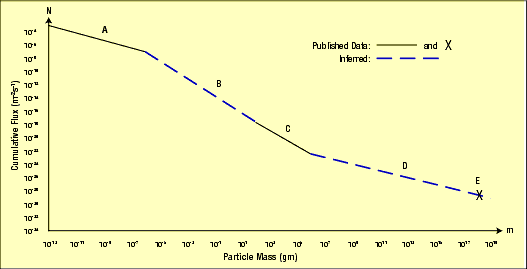Integration
The general form of the cumulative flux curves is
log N = a + b log m
which is equivalent to
where n(m) is the distribution function of the number of particles of size m.
Differentiating both sides of the right equation above with respect to m gives
10 a (b) mb-1 = - n
Multiplying the number of particles (n) in a narrow mass range (dm) by the mass m and then integrating between m1 and m2 gives the total mass within that size range [m1 – m2] that accumulates per square meter per second.
Within this mass range, the thickness (t) of pulverized meteoritic material that will accumulate on the Moon’s surface in 4.6 × 109 years, if the influx has always been at today’s rate, is
where

and the density of the pulverized lunar crust is 2 gm/cm3.
The total thickness of meteoritic material and pulverized Moon rock during 4.6 × 109 years is
(tA + tB + tC + tD) 67
where 67 is the ratio of the pulverized Moon rocks to meteoritic material. Table 106 gives the calculated values for the various thicknesses.
We will disregard debris contributed by the region to the right of Point E.
